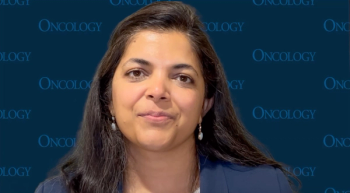
Cladribine Plus Upfront Rituximab Shows Promise in Hairy Cell Leukemia
Researchers tested simultaneous vs delayed rituximab with cladribine in patients with hairy cell leukemia.
Cladribine plus simultaneous rituximab led to a greater frequency of minimal residual disease (MRD)-free complete response in patients with hairy cell leukemia compared with delayed rituximab. It remains to be seen if MRD-free complete response holds promise for a cure, but the results prompted excitement for further study. These results (
Single-agent purine analogs like cladribine are the standard of care for hairy cell leukemia and achieve good complete response rates, but relapses do occur and there is no plateau of survival even in the presence of complete response.
Positive MRD status is associated with shorter disease-free survival in hairy cell leukemia, but MRD status after cladribine therapy, with or without concurrent rituximab, has not been well studied. There is ex vivo evidence that rituximab may make cancer cells more vulnerable to cladribine.
“It looked like very impressive results on the combination of upfront cladribine and rituximab, resulting in a very prolonged overall survival and also a high percentage of MRD negativity. The data look very good. It looked like the concomitant upfront administration is better,” said
In the study, researchers randomized 68 patients with previously untreated hairy cell leukemia to cladribine plus rituximab or to cladribine alone (delayed rituximab). After at least 6 months, both arms could receive 8 weekly doses of rituximab if flow cytometry was positive in blood or they still had abnormal complete blood count associated with hairy cell leukemia. All patients were allowed up to 2 courses of rituximab, so the delayed group could receive a further course if needed.
The two treatment groups had similar baseline characteristics, except that the delayed group had slightly higher hemoglobin levels at baseline (12.8 g/L vs 11.8 g/L; P = .037).
The median follow-up was 7.7 years. To test for MRD-free complete response, the researchers used peripheral blood flow cytometry, bone marrow immunohistochemistry, and bone marrow flow cytometry. At 4 weeks, all 3 tests were negative in 62% of the combined group and 9% of the delayed group (P < .0001). At 6 months, 100% of patients in the combined group had a complete response, as did 88% in the delayed group; 97% in the combined group had MRD-free complete response compared with 24% in the delayed group (hazard ratio [HR], 0.035; P < .0001).
Among those who achieved MRD-free complete response, 33 of 34 patients in the combined group were MRD-free at 100 months. Twenty-one patients in the delayed group also eventually achieved MRD-free complete response, but the durability was greater in the combined arm (HR, 0.12; P = .025).
Grade 3/4 thrombocytopenia was more common in the concurrent arm (59% vs 9%; P < .0001), but this was not associated with significant bleeding.
Newsletter
Stay up to date on recent advances in the multidisciplinary approach to cancer.

















































































